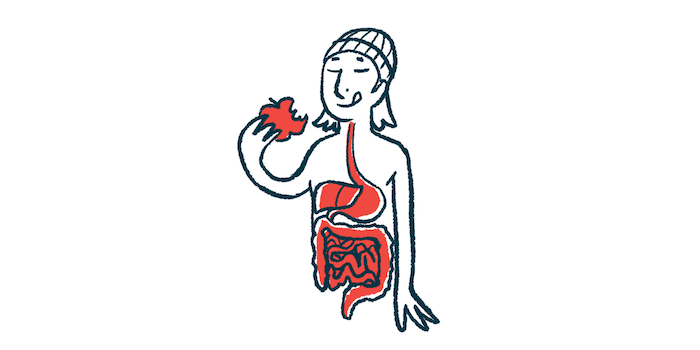Kaftrio May Ease CF Symptoms of Acid Reflux, Sinonasal Infection
Written by |

Kaftrio, a triple combination of elexacaftor, tezacaftor, and ivacaftor sold as Trikafta in the U.S., may ease acid reflux and symptoms of nasal and sinus cavity infection in cystic fibrosis (CF) patients with advanced lung disease, a U.K.-based study found.
The study, “Elexacaftor-tezacaftor-ivacaftor improve gastro-oesophageal reflux and sinonasal symptoms in advanced cystic fibrosis,” was published in the Journal of Cystic Fibrosis.
People with CF carry mutations in CFTR, a gene that contains the instructions to make a protein of the same name. The protein is an ion channel that works on the surface of a cell to control the traffic of salt and water into and out of it. This allows mucus in the lungs and the airways, and digestive juices in the gut, to flow smoothly.
The mutations cause changes to the protein’s shape, which prevent it from working well or even reaching the cell’s surface. This can cause a thick mucus to build up in the lungs and airways, making it hard to breathe and easy for an infection to spread. In the gut, it can make the acid the stomach makes to break down food to move up, causing heartburn and discomfort.
Vertex Pharmaceuticals’ Kaftrio is a CFTR modulator used by people with CF due to at least one F508del mutation in CFTR — the most common mutation causing the disease — or certain other mutations. Two of its components, elexacaftor and tezacaftor, help the CFTR protein fold into the correct shape. The other, ivacaftor, helps hold the ion channel open for traffic. Together, they make mucus and digestive juices thinner to ease the disease’s symptoms.
Researchers in the U.K. wanted to find out if Kaftrio could ease acid reflux and symptoms of rhinosinusitis (an infection of the nose and sinus cavities around the nose).
“Upper gastro-intestinal and upper airway disease are particularly important in advanced CF because they persist post-transplantation and may have adverse effects on the lung,” the researchers wrote.
The study included 32 patients with CF (23 men and nine women) who had a median age of 32.5 years and were being started on Kaftrio. They had advanced lung disease, with a mean forced expiratory volume in 1 second (FEV1%) of 24.8% that indicated poor lung function. All were facing the possibility of a lung transplant.
Of the 32 patients, 22 (69%) had two copies of the F508del mutation. Some 22 (69%) had received tezacaftor and ivacaftor — a combination marketed as Symkevi; Symdeko in the U.S. — before starting Kaftrio, and 27 (84%) were receiving proton pump inhibitors or H2 receptor antagonists to reduce the amount of acid made in the stomach.
As part of the study, the researchers asked the patients to fill in questionnaires at the start and at three and six months after beginning Kaftrio.
The questionnaire used to assess acid reflux was the reflux symptom index (RSI). When the researchers watched for changes in the RSI scores, they found they dropped significantly from a median 15 points at the beginning of the study to five points after six months on Kaftrio. A score of less than 12 points indicates no symptoms of acid reflux.
Airway reflux was assessed using the Hull Airway Reflux Questionnaire (HARQ). Its scores dropped significantly from a median 26.5 points to 7.5 points after six months on Kaftrio.
At the beginning of the study, the median score on the Sinonasal Symptom Test 20 (SNOT) was 36.5 points, indicating symptoms of rhinosinusitis. After six months, the median score dropped to 20 points, which exceeded the minimal clinically significant change.
When the researchers watched for differences in lung function, they found that the mean FEV1% had risen by 9.2 points to 34.0% after six months on Kaftrio.
There also was an improvement in body mass index (BMI), a measure of body fat based on height and weight. After six months, the mean BMI had risen by 2.6 kilograms per square meter (kg/m2), from 21.3 to 23.9 kg/m2.
“In addition to improving lung function and weight, CFTR modulators improve upper airway and gastro-oesophageal reflux symptoms in advanced CF,” the researchers said.
All these improvements occurred as early as three months, and were maintained for at least six months of treatment with Kaftrio.







